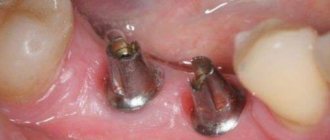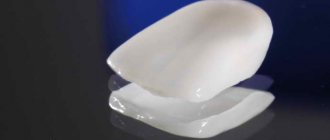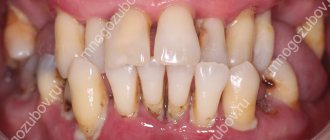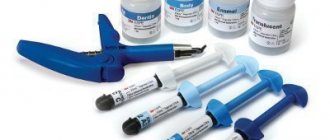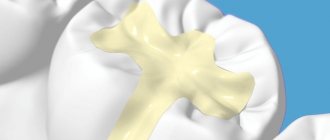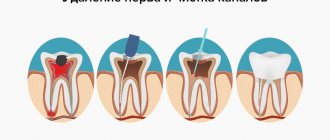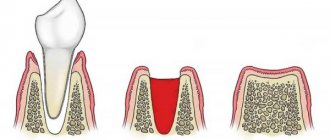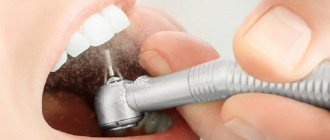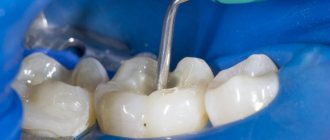General overview of the system
A dental implant (rod) is an artificial analogue of a tooth root, made of high-strength and hypoallergenic titanium.
In appearance, the root implant is a unique element equipped with a micro-rough surface and a screw line (thread).
After implantation of the implant into the bone, the process of osseointegration begins - the growth of bone masses into the porous structure of the rod due to its relief surface. Upon completion of this stage, the specialist performs prosthetics of the artificial root with a microprosthesis - a crown.
The design features of titanium implants ensure reliable fixation of the rod in the bone structures and soft tissues of the jaw arch.
The product consists of the following elements:
- An implant is a prosthetic tooth root made of titanium, which is inserted into the bone by screwing.
- A gum former (not installed in all cases) is a device that helps create a neat gingival contour.
- Abutment (connecting link) is the final root part, which is fixed on the rod after its complete healing and connects the body of the implant to the crown.
- Crown (coronal part of a new tooth) – is attached to the abutment and is the final element that allows you to fully restore a damaged or lost tooth.
Depending on the method chosen for implantation, as well as the type of implant, the crown can be installed at different times after completion of the operation.
The crown is not installed on the implant itself, but on the abutment, which plays the role of a transition device.
It is important to note that this element is made of ceramic or metal and is pre-turned, which makes it possible to achieve anatomical similarity to the tooth stump.
The entire implantation system must be firmly fixed in the jaw tissue.
It’s sad when, during the use of a new tooth, not only its crown part begins to wobble, but also the implant itself. This clinical picture indicates that the implant has not taken root properly in the bone structures.
There is a need to conduct diagnostic studies that will help identify the cause of what is happening. There can be many factors that can provoke the occurrence of this problem; below we will consider them.-halo.html we will discuss the features of Shofu metal ceramics.
Features of installing crowns
In dental practice, at least 50% of all prosthetics are crowns. They are made from various materials: from economical plastic to durable metal-ceramics. They are made individually and placed on the stump that remains after the destruction of a molar. According to the technology, the miniature shell is attached to special cement. This adhesive mixture hardens quickly and securely glues the prosthesis to the enamel.
Sign up for a free consultation:
Subscribe to the newsletter about promotions of the Treatment Center
I agree to the processing of my personal data
Most patients are confident that after installation the crown should last for many years without changes. But even the most modern materials are designed for 4–7 years of operation, after which correction or complete replacement is necessary. Periodontal diseases and frequent inflammation of the gums and bone tissue contribute to rapid wear and tear. A person notices that the crown on the tooth is loose, and there is a putrid smell or pain. One of the disturbances in the dentist’s work may contribute to a kind of depressurization:
- The specialist did not take into account all the structural features of the jaw and the condition of the bone. Advanced and chronic inflammatory processes contribute to its subsidence and deformation, the shape of the face and chin changes. Problems often arise when there is a pronounced malocclusion.
- The crown was placed on a “dead” base. For high-quality work, the sensitivity of the roots and nerve endings should be preserved as much as possible. Otherwise, the stump will quickly die and collapse, and the prosthesis will simply have nothing to support it.
- During the fastening of the structure, the adhesive cement must be constantly cooled. High temperature greatly affects strength and density, the structure becomes porous and brittle. After a few months, such a crown becomes loose on the teeth and creates discomfort. A gap is formed into which food debris gets trapped and active rotting begins.
The skill of the orthodontist who makes the structure is also of great importance. Ideally, it should follow all the curves and gaps as accurately as possible. Only in this case will it fit tightly and not be felt. Sometimes it goes too deep into the mucous membrane and disrupts blood circulation in it, causing swelling and discomfort.
Useful tips for those who have lost a crown: what you can do and what actions are strictly prohibited
The field of dental services today is quite well developed, but sometimes unpleasant situations happen to patients, for example, when a crown falls off a tooth. Everyone knows that artificial crowns are designed for long-term use, so when such a problem arises, many questions arise that you want answers to. You will find the most complete and up-to-date information on the topic in this article.
We suggest you read How to relieve toothache in a child: how to relieve and how to soothe if children have toothache
Why a crown may become loose and what to do about it
Sometimes a condition may occur when the installed crown becomes loose. Why this happens and what to do in this case, you should understand in more detail.
Crown shape mismatch
The inner surface of the crown must be an exact copy of the surface of the tooth, regardless of the material used. This not only guarantees a tight fit, but also ensures a long service life. The stump-shaped inlay is recreated according to an individual cast and consists of two parts - the crown and the inlay itself (pin), so prosthetics occurs in stages. Compliance with the standards ensures reliable connection of all structural elements. The walls of the tooth and surrounding tissues will experience minimal stress, which will protect it from destruction, and the tooth will not wobble.
The pin is poorly secured
Important points, the observance of which ensures high-quality fastening of the stump:
We cannot exclude the fact that the body could simply reject a foreign object. As a rule, this occurs due to allergic reactions and severe swelling of the gums. Inflammatory processes may begin.
Cyst as a cause of loose crowns
With the correct approach to installation, the dentist must first thoroughly sanitize the teeth. They need to be treated and all canals must be thoroughly sealed to ensure their healthy condition. The “hemp” pulp is closed with a high-quality filling, and the rest is ground to the optimal shape. If insufficient disinfection was carried out during the process or germs got inside with instruments, painful inflammation cannot be avoided.
Active proliferation of bacteria begins a few days or weeks after fixation of the prosthesis. The first sign of pus is tingling and tugging pain when chewing. The slightest pressure on the stump responds with pulsation, the following symptoms appear:
- a small tubercle or bump forms at the base, protruding outward;
- the pain intensifies when lying down, when lowering the head, and prevents eating;
- the crown rises up and wobbles, it is impossible to close the jaw completely;
- the temperature may rise.
In most cases, the occurrence of a cyst on the root of a tooth is associated with the negligence of the dentist, who neglected the rules of disinfection or antiseptics. If you experience aching or shooting pain, you should urgently visit a dentist. Treatment of such a problem occurs only after the crown is removed. Based on the x-ray, a decision is made: whether the stump can be saved or whether it will have to be pulled out.
After removal of the cyst, the patient undergoes repeated root canal treatment within 7–10 days. Sometimes you have to use antibiotics and wash the exposed pulp with an antiseptic like Miramistin or Furacilin. Only after complete healing can a repeat impression be made and a new onlay made.
This is interesting: Denture care: how to properly clean and store
The tooth is loose under the crown
All of the above factors lead to the tooth starting to loosen under the crown. Under no circumstances should you try to remove it yourself. In this case, the cause of this condition should be determined.
First of all, you should evaluate the swelling of the gums and the change in the gingival margin as a whole; perhaps this factor affects the density of the abutment. It is possible that the tooth under the crown is affected by caries, which will subsequently lead to its decay.
Gingivitis with loose crowns
If the crown is poorly fixed during installation, a gap remains between it and the gum of more than 0.3 mm, creating an ideal environment for the growth of bacteria. Particles of food and plaque get stuck in the space. Under the influence of saliva, they decompose, and inflammation of the soft tissue begins. Redness and swelling extend to the space between the teeth. Characteristic signs indicating gingivitis:
- bad breath;
- bleeding when brushing teeth;
- severe swelling of the mucous membrane;
- unbearable pain, acute reaction to hot and cold food.
You can get rid of the disease only under the supervision of a dentist. It is necessary to eliminate the cause of inflammation, for which the crowns are removed. A comprehensive cleaning of all teeth is carried out using ultrasound and other modern plaque removal techniques. To relieve swelling and severe redness, rinse the mouth with an antiseptic several times a day:
Sign up for a free consultation:
Subscribe to the newsletter about promotions of the Treatment Center
I agree to the processing of my personal data
- Stomatophyte;
- Chlorophylliptom;
- Rotokan;
- Miramistin;
- Furacilin;
- Tantum Verde.
Often, suppuration begins under the crown. It should be stopped with antibiotics to prevent infection of the bone tissue and periodontal tissue. For this, Tetracycline, Clindamycin or Ciprofloxacin is used. The course of therapy is calculated individually and lasts on average from 5 days.
Swelling due to gingivitis leads to pressure on the lower edge of the denture. It cuts into the mucous membrane, leaving wounds on the gums. They heal poorly due to large amounts of bacteria and plaque. Such inflamed areas can be treated with special ointments. They contain softening oils, healing ingredients and vitamins. The most effective for exacerbations are gels with a light texture: Solcoseryl, Cholisal, Asepta, Metrogyl Denta.
Deconsolidation
To install a crown on a tooth, you need to cover the part above the gum with a custom-made cap. This device is attached in several ways - on a pin, onlay or on your own tooth, but for a number of reasons the structure can move from the stump or even fall out after some time. Disintegration factors:
- The choice of low-quality materials causes instability of fixation. The device is attached weakly and does not create a reliable connection, and the cement used forms a small layer between the crown and the tooth. The pin height is too low.
- Incorrect dilution of dental cement (too thick or thin). Strict adherence to proportions is mandatory.
- It is necessary to take into account the bite, since improper closure of teeth can cause cracks and chips during restoration.
- When preparing, the dentist must precisely grind the ledge to ensure the crown is positioned correctly and tightly. Strict compliance with all requirements will prevent food from getting under the product.
Why it hurts: causes of the symptom
Important. Any inflammatory process is the result of bacterial activity. Before starting treatment, it is important to establish the true cause.
There can be a lot of options here.
- Poor preparation of the oral cavity before installing a crown.
- The gums were injured by the prosthesis.
- Due to an incorrect bite, the crown puts too much pressure on the gums.
- Root perforation. During the treatment, the doctor accidentally made a small hole in the root of the tooth. Only an x-ray can detect the defect.
- If the crown does not hold well, a hole will form between it and the tooth. Residues of food will get into it and thereby cause tissue inflammation.
Less common factors that provoke the inflammatory process are:
- diabetes;
- disruption of the digestive system;
- improper metabolism (pregnant women or women during menopause often face this problem);
- hormonal disbalance;
- lack of vitamins and minerals (poor nutrition, diet).
Reference! The tooth crown may become damaged after installation. The tightness is lost over time. The result is the entry of bacteria.
Among other things, improper care affects the health of the gums. For example, brushing your teeth too vigorously, ignoring dental floss and mouthwash, or using the wrong brush.
What affects the strength of cement
Installing a crown helps protect the tooth from wear and tear; this device is used to strengthen the dentition. If the crowns begin to become loose, certain factors may influence this. When installing a crown, it is necessary to comply with certain requirements for the shape of the stump on which the product is attached. The height of the dental inlay should be at least four millimeters, the taper should be no more than eight degrees, and the thickness of the volume of tissue for grinding should not be more than one and a half millimeters.
The listed factors regarding the shape of the stump insert directly affect the strength of the product. If any requirements are violated during installation, it can lead to the tooth under the crown starting to hurt, become inflamed, and subsequently the crown on the tooth becomes loose and becomes uncemented. Another factor that influences the fact that a tooth becomes loose can be the shape of the gingival ledge. If it is correct, the gums will not subsequently become inflamed and gradually collapse. If the crown is installed, but the gingival ledge is incorrect, this risks the gums becoming constantly inflamed and chronic local periodontitis beginning.
Another factor that can influence the appearance of a wobbly device is the structure of the stump tissue after turning for the structure:
- During preparation, it is important to try to preserve the structure of living tissue. This can be achieved if the tooth canals are not filled.
- During the preparation process, ample water cooling is important. In the absence of this factor, the tissues may overheat, their hardness and elasticity deteriorate, and as a result, this may cause the crowns to become loose. They can only be restored through complete replacement. To do this, the device is removed from the pin and replaced in compliance with all necessary requirements.
It is important that the higher the quality of the tooth tissue, the stronger the adhesive properties of dental cement will be.
What else affects an artificial loose tooth:
- for successful prosthetics, it is necessary to take into account all the rules of occlusion of the patient, as well as the characteristics of his bite, the condition of the gums and bone tissue;
- Local restoration of the dentition is not recommended. It is important to begin with a complete rehabilitation of the dental system.
Why does cementation occur?
When installing a crown, the supragingival part of the tooth is covered with a created cap. Such a device can be attached to a pin, or the base for attachment can be an inlay or your own tooth. Sometimes a condition occurs that the structure has left the stump. This happens due to certain reasons.
When using low-quality materials, the fixation is fragile, the device may not be installed tightly, and the cement used only fills a thin layer between the natural tooth and the device. If a metal-ceramic crown becomes uncemented, this is due to the fact that the structure was not made correctly. Mobility due to cement occurs only when the cement is too thick or too thin.
Sometimes an artificial tooth becomes loose due to an incorrect bite. A specialist must take this indicator into account in order to further prevent cracks and chips of reinforcing products. Motility occurs due to food particles getting under the cap. This happens due to an incorrectly prepared ledge and a loose fit of the device to the gum.
The shape of the inner surface of the product should be similar to the surface of your own tooth. This will ensure a tight fit and long service life of the device. If the fit is not tight, the structure will be removed after a short period of time. It can be summarized that the main reasons for de-cementing can be:
- Inaccuracy of the manufactured product, incorrectly selected shape.
- Stump height too low.
- Large preparation angle.
- Malocclusion.
- Failure to comply with cement mixing proportions and poor quality.
Inaccurate crown manufacturing
Dental technicians make dental crowns. At the initial stage, an impression is made of the patient’s jaw and a plaster model is built. The doctor cuts out the required tooth from the model and forms a wax mold. After hardening on the base, the element is placed in the oven for 4-6 hours. After burning out, the liquid alloy is poured into the heated mold.
This is interesting: How to install a crown on a tooth: nuances of preparation, stages
An error at any of the manufacturing stages can cause complications. If the required tightness is not observed, food debris will penetrate under the crown, which is a beneficial bacterial flora, ensuring a favorable course of bacterial proliferation in the oral cavity.
The danger for the patient is not only premature loosening. If these symptoms are ignored, the rotting process may start.
Low pulp height
To maintain the necessary vital activity of the pulp during preparation, it is recommended to leave a minimal layer of dentin. The thickness is determined on an individual basis after considering the patient's age and dental condition. It is worth remembering that difficulties and mistakes are often made at this stage, because even an x-ray allows one to obtain only approximate data on the condition of the pulp chamber.
Large preparation angle
The doctor must determine the minimum acceptable preparation angle that ensures full adhesion of the tooth and crown. At this stage, the main goal is to preserve the tissues of the periodontal sulcus. When creating a ledge, gum retraction is performed.
Malocclusion
An incorrect bite causes uneven distribution of chewing loads across the entire dentition. Dental tissues are constantly under stress, as a result of which they become thinner. In some cases, such pathology is considered a contraindication to prosthetics.
The decision on the possibility of carrying out manipulation is made by the attending physician on an individual basis. The patient must remember that malocclusion requires longer and more careful work by the orthodontist.
Failure to comply with cement proportions
A common cause of increased structural instability is a mistake by a specialist or his assistant. As with filling, a special solution is used for installation, which is mixed immediately before use.
The reason for the active looseness of the crown often lies in non-compliance with basic technologies, for example, violation of the proportions of cement mixing. The solution under such conditions is not able to fully perform its functions, which causes premature loosening.
Reasons for crown mobility
If the implant is loose, this may be due to the procedure being performed in the presence of relative contraindications. Theoretically, prosthetics can be performed if they are available by an unqualified specialist, but the risk of complications in such cases increases. Such contraindications include:
- bleeding disorders;
- diseases of the cardiovascular and nervous systems;
- malignant and benign neoplasms;
- malocclusion, bone defects;
- diseases of the immune system, immunodeficiency;
- systemic connective tissue disorders;
- chronic periodontitis;
- hyperglycemia, diabetes mellitus;
- hepatitis;
- age up to 16 years.
If this is not your case, read on.
If you have a crown placed on a round abutment, it may come loose. This happens and leads to her mobility. To understand the reason for the loosening of the screw, the prosthetist can ask you to take a targeted photo of the problem tooth.
Reasons for loosening due to the patient's fault
Sometimes artificial teeth begin to loosen due to the patient’s fault. This happens if a person:
- takes medications without consulting a doctor;
- does not take good care of the oral cavity;
- refuses to take antibiotics prescribed by the dentist;
- overloads a newly installed structure;
- does not follow the recommended diet;
- smokes in the first days after implantation or drinks alcohol;
- goes to the bathhouse or sauna while the wound is healing;
- behaves carelessly, resulting in injuries to the jaw.
Medical error
If the structure was installed incorrectly, the result is wobbly. A medical error may include the following:
- use of an unsuitable implant;
- incorrect assessment of the condition of bone tissue;
- ignoring existing contraindications;
- violation of asepsis rules;
- overheating of the bone during drilling.
Poor quality materials
The reason why the crown on the implant is loose may be the use of low-quality raw materials. Some clinics skimp on consumables and install cheap rods that do not take root well or are rejected by tissues.
To avoid such developments, you need to contact trusted medical centers with a lot of positive reviews. Such institutions use raw materials and equipment that have passed quality control.
Titanium rods are most often used to restore teeth. They have a porous structure, so they are securely fixed in the surrounding tissues and quickly take root.
Signs of rejection
On average, the implant takes about 3 months to take root on the mobile jaw and 6 months on the upper arch. This discrepancy in timing is due to the fact that the lower jaw bone receives better blood, it is generally larger and denser, and the strongest chewing pressure is exerted on it.
In addition, a large air sinus is visible above the upper jaw bone, the close location of which in most cases creates additional difficulties in the implantation process.
Osseointegration is the phase of fusion of a metal product with the soft and hard tissues of the jaw, which is activated immediately after installation manipulations.
The duration of the engraftment period largely depends on the initial state of the dentofacial apparatus, as well as on the quality and model of the artificial root itself.
Moreover, it does not matter which implantation technique was chosen. That is, it does not matter whether the implant is loaded immediately (simultaneous implantation) or after complete engraftment with tissues - in both the first and second cases, the period of osseointegration has almost the same duration.
According to statistical data, rejection of the dental root analogue most often occurs in the first days after it is screwed into the bone. If complications or unforeseen troubles occur, the first symptoms usually appear quickly.
However, you should not lose your vigilance. Even successful implantation of the system cannot completely eliminate the possibility of rejection. Pathological changes can occur even after several years of active use of a new tooth.
The main signs that the design is not ideal:
- the appearance of painful sensations a week after installation (the norm is 3 days of painful discomfort);
- prolonged swelling of the gum tissue (with inflammation, swelling persists for more than 5 days);
- sharp pain when pressing , accompanied by pulsation (this symptom is pronounced in the case of replacing a chewing tooth with an implant, since it is these organs that take on the load more than others during meals);
- unsteadiness of the structure (proper fixation of the implant and crown prevents displacement, and if the position of the elements has changed, then a problem has arisen that requires immediate correction);
- bleeding of the wound site for more than 7 days;
- daily metallic taste in the mouth;
- redness of the gum tissue in the implantation area;
- general weakness of the body , which cannot be justified by another reason;
- the appearance of purulent exudate from the wound;
- unpleasant odor emanating from the wound area (a clear sign of an inflammatory process).
Remember! If the position of the structure is broken, it is important to immediately seek help from a specialist. It is very unwise to delay emergency treatment.
This can lead to destructive processes in bone tissue and complete destabilization of the system, up to its loss.
A piece of the crown broke off
When treated with crowns that consist of a metal frame and veneer, complications such as chips and cracks are possible. They occur when excessive pressure is applied to the crown, and ceramic or plastic detaches from the metal. If a small piece of material breaks off, it can be replaced using filling materials.
We invite you to read: Is it possible to treat teeth during pregnancy? || Is it possible to get a filling during pregnancy?
If there is a large structural defect, you can try to restore the shape of the crown by sending it to a dental laboratory for repairs. If a significant part of the structure breaks off, then it is better to make a new product.
What to do
First, the crown must be removed by a doctor; you should not try to remove it yourself. After this, all softened tissues that cannot bear the load and provide adhesion are removed.
Next, you need to restore the shape of the stump tab. After which a new crown is made and installed. How to strengthen teeth is decided in each specific case by the doctor after a preliminary examination, taking into account the condition of the oral cavity - gums and bone tissue.
Independent actions
If the pin falls out along with the crown, it can be restored in the clinic after a professional examination by dentists, if the structure was not destroyed. If the crown has fallen off at home, you can do the following yourself:
- If the crown is removed, the stump is cleared of the remaining cement mixture.
- The mouth is rinsed with a solution of Chlorhexidine or hydrogen peroxide.
- If the stump hurts, buy Analgin, Nimesil or Ibuprofen at the pharmacy for pain relief.
- The fallen structure is folded into a box and stored until an appointment with the doctor.
- Depending on the chosen composition, the structure is fixed for 15 days.
- The patient should avoid putting stress on the damaged tooth area.
Analgin Nimesil Ibuprofen
The doctor, after a professional examination, will name the cause of the problem. If there were technological violations during the installation of the structure, then treatment or restoration of the pins is carried out free of charge.
Bonding the prosthesis
If the crown on a tooth wobbles, you cannot loosen it even more on your own. It is better to seek help from the dentist who installed the pin. He will give the right recommendations and correct his work. If the crown falls out, it must be saved, placed in a safe place, and immediately contact your dentist. The tooth stump is very fragile, so there is always a danger of damaging it. Before installing the pins, the teeth must be carefully protected. Do not place a large chewing load on the prosthesis.
Many patients wonder if the crown has come off a tooth, what to do with it. This cannot be done, because it can harm the integrity of your teeth. The dentist may void the warranty on his or her work. Before visiting the doctor, carefully clean the stump and rinse your mouth with antiseptic compounds. If a complication occurs, the orthopedic structure is preserved and cannot be thrown away. It is placed in a box or container where the prosthesis will not be damaged or deformed. After the pin falls out, a hole remains in the gum, which must be closed with a piece of cotton wool while eating.
It is strictly not recommended to glue lost teeth with cement or dental compound yourself. If it is not possible to visit the dentist in the near future, you can temporarily use the painkillers described above. Inept use of medications to independently install a temporary filling can cause irreparable harm to your health.
Theoretically, the cement medicament can hold the crown in place for about two weeks, but it can damage the teeth. The patient will not be able to install the crown on his own and carefully get rid of the old cement.
This is interesting: Preparation of teeth for veneers: the need for grinding, methods and stages of the procedure
If the crown is loose or the pin has fallen out, it is not recommended to take any action at home to install the structure in its place. You should immediately contact your doctor for professional help. Only he will be able to prescribe the correct treatment and establish the reasons why the trouble occurred.
What to do if the implant has already fallen out
Not all patients have time to receive medical care when the implant swings. Sometimes it falls out on its own and you have to act quickly. Treatment begins with cleaning the hole and prescribing antibacterial drugs. After eliminating the inflammatory processes, an examination is carried out, the purpose of which is to establish the cause of rejection and draw up a new orthopedic treatment plan.
The procedure for dealing with a rod falling out is the same as for staggering. It depends on what caused the rejection. If the problem arises due to insufficient bone volume, osteoplasty is performed. This is followed by a healing period of 2 to 5 months. A new structure can be installed only after the bone tissue has completely recovered.
If the cause of rejection is increased sensitivity of the body or individual intolerance, new rods made of a different material are installed.
It is possible to save the old structure in only 2% of patients. In other cases, new rods take the place of the old pins. While they are being manufactured, the dentist can offer the patient a clasp or nylon denture.
When is it necessary to remove a crown from a tooth?
Removing the crown from a tooth needs to be done only when there is a serious need for it, because the crown itself can be used for 7-10 years or more (the time period depends on the material from which the prosthesis was made).
Let us list the reasons why it is necessary to resort to such manipulation:
- a disease has developed under the structure: for example, secondary caries, periodontitis or a cyst,
- errors made at one of the stages of prosthetics: perhaps the crown does not correspond to the individual characteristics of the patient, is poorly installed and adjusted, is made of low-quality materials,
- the patient’s desire to replace the structure with a prosthesis made of a better and more beautiful material: for example, replace a metal or metal-plastic product with metal ceramics or zirconium dioxide,
- injuries that led to damage and breakage of an artificial tooth,
- destruction of permanent cement on which the orthopedic structure was fixed,
- The product has expired.
The reason for removal may be the development of caries under the crown
If the tooth under the crown hurts, there is a bad smell, and the structure has become shaky and movable, then it’s time to visit a dentist, who, based on an examination and x-ray, will decide on the need to remove and replace the artificial material.
According to numerous studies, the need to prematurely remove crowns already in the first years of use in 40% of all cases arises due to the fact that poor-quality endodontic treatment and poor-quality sanitation of the oral cavity were performed before preparing for prosthetics.
All of the above reasons are a serious reason to think about removing the prosthetic structure. Naturally, first you need to go to an appointment with a dentist, who will explain how crowns are removed from teeth. And we will look at the methods that exist today.
Techniques
In dental practice, various methods of removing crowns are used. The choice depends on the existing clinical picture and the target direction of dismantling.
The decision on the method used is made by the patient, taking into account his financial capabilities and the time he can devote to it. Let's consider the existing options in detail.
Kopp apparatus
A crown remover is a dental instrument that greatly simplifies the work of a specialist and gives him the opportunity to painlessly remove the prosthesis without resorting to its destruction.
The device looks like a special hook , the operation of which is started by a button located on the holder. The procedure begins with breaking the cement under the structure using a drill. Next, using special forceps and hooks, the crown is picked up and picked out.
The method is considered a low-traumatic and painless procedure. However, it has one significant drawback - in some cases the device leaves scratches on the ceramic coating of the product , as a result it will require restoration.
Coronaflex device
The device operates on the basis of compressed air , which destroys cement. At the beginning of the procedure, the device should be operated with minimal impact force to avoid damage to the tooth.
The crown in the chewing area is removed using forceps. The device is installed so that its body is under the arc of the forceps.
special brackets as auxiliary tools , which are fixed on the crown using an adhesive system. Then the procedure continues according to the principle of the previous method with forceps.
When using the Coronaflex device, there is practically no risk of damage to a fixed prosthesis , but the price of the instrumentation is quite high, which affects the cost of removing the structure.
For this reason, the use of the device is justified in a situation when it becomes necessary to dismantle an expensive crown, for example, made of zirconium dioxide.
Sawing
After using this method, repeated prosthetics with the same design is impossible.
Many patients mistakenly believe the procedure is painful, but in fact their fear is in no way justified. During sawing, the patient does not even experience any discomfort.
As a rule, this method is used in the case of inexpensive products that are subject to liquidation. Usually we are talking about metal ceramics.
However, specialists often resort to cutting to remove ceramic crowns, which requires the use of a diamond bur and special tools .
Ultrasound
Under the influence of a sound wave, cement loses its stability. But this method is not applicable to every material.
If we are talking about glass ionomer cement (a material based on polyacrylic acid and aluminofluorosilicate glass powder), its use is devoid of expediency and practical benefit.
Thanks to this method, the doctor can preserve the model and its shape without damage.
The video shows the process of removing the crown.
About pain and self-liquidation
The level of complexity and pain of each of the listed methods depends on the experience and professionalism of the doctor.
If the removal of the structure involves the destruction of the cement base, the crown easily falls out, such manipulation is easy and painless.
If a fixed prosthesis is installed firmly and stably, and dismantling requires maintaining the integrity of the product, the duration of the procedure increases, which causes discomfort in the patient. In such cases, the use of anesthesia is appropriate .
If there is severe pain under the structure, a person looks for forced ways to eliminate the product at home. Lack of experience and special equipment are considered to be the cause of adverse consequences.
Any attempts to independently remove the prosthesis lead to its damage or injury to the soft tissues of the oral cavity.
For this reason, such manipulations are carried out in a clinical setting. A qualified doctor with special equipment will perform correct crown removal.
You can remove the orthopedic device yourself in two cases:
- the product has become loose or has come off together with the cement base;
- the structure fell apart and it became necessary to extract the remaining fragments.
To avoid further complications, a person should seek help from a specialist as soon as possible.
Front. Dental care
Dental care for damaged crown stability consists of identifying and eliminating the cause of the pathology and restoring the aesthetic appearance of the dentition.
To solve the problems of loose teeth in the case of premolars, molars and wisdom teeth, various methods are used depending on the identified cause. Most often, this condition of the molars is provoked by the presence of an infection inside the tooth and periodontium, which provokes the formation of a cyst.
Often, such problems arise due to periodontal disease or improper bite development.
The most common problem with the anterior upper and lower crowns is their pathological mobility. To eliminate it, the dentist will conduct a detailed examination and identify the main cause of the pathology. This may require the help of other specialists.
At this stage, it will be necessary to conduct an x-ray examination of the anterior part of the jaw.
Regardless of the reason, the first step is hygienic professional cleaning, which stops the further spread of infection.
Depending on the reason, the following measures can be taken:
- when periodontal disease is detected, the dentist performs a professional gum massage and a periodontal acupressure shower;
- darsonvalization is prescribed;
- in case of periodontitis, deposits are removed and the crown is polished using ultrasonic equipment;
- the neck of the tooth and its main surface are treated with a special brush and varnish containing fluoride;
- just as in the case of molars, closed or open curettage is used.
With closed curettage, curettes, excavators, and hooks are used to remove deposits by penetrating under the gum. With open curettage, an incision is made in the gum, deposits are removed and it is further sutured; - In addition to mechanical effects, anti-inflammatory drugs and antiseptics are prescribed. For example, “Rekutan”, “Vokara”;
- In case of injury to the anterior crown or their fan-like divergence, splinting is performed to ensure their artificial strengthening. To do this, a groove no more than 2 mm deep is drilled into the enamel.
Fiberglass is laid into it and then filled with a reflective composite. Splinting prevents further loosening during chewing and mechanical stress.If, due to injury, the crown was broken off and the root was damaged, the fragments are completely removed. The defect is eliminated at the request of the patient using crowns made of various materials.
We suggest you read: I bit my cheek from the inside and an ulcer formed, how to treat it photo
The success of the treatment will depend on timely treatment, detailed diagnosis and strict adherence to the dentist’s recommendations.
Mobility of temporary teeth requires special attention only during a certain period. If loosening occurs at the time of changing temporary crowns to permanent ones, then you can take this calmly.
Root resorption occurs gradually. The crown part is held by the base only by the edges of the gums. The growing new tooth gradually pushes out the old one. If no inflammatory phenomena occur, then the help of specialists is not required.
But in a situation where it is not yet time to change the crowns, but the tooth is mobile, it is worth contacting a dentist.
In this case, certain measures are taken:
- if the loosening is caused by dental inflammation, then treatment is carried out with cleaning and further filling of the canals;
- in case of inflammation of the gum tissue, the child undergoes gentle cleaning of the crowns and is prescribed physiotherapeutic treatment;
- if the mobility of the crown affects the formation of the bite, then splinting or installation of reinforcing dental structures is carried out;
- If the above methods are ineffective, the loose tooth is removed using local anesthesia.
Tooth mobility is a problem that requires immediate attention to a dentist in most cases. Delaying the treatment process can lead to their complete loss.
If you find an error, please highlight a piece of text and press Ctrl Enter.
Prevention measures
To prevent crown loosening, you must:
- Clean your teeth, gum tissue, tongue and dentures daily to remove bacterial plaque. To do this, you need to purchase special hygiene products, including a brush with gentle bristles.
- After eating, remove food particles from interdental spaces. Dental floss is ideal for this.
- Do not overload the implant system with excessive chewing pressure.
- Remove very hard and hard foods from your diet.
- Follow the schedule of preventive examinations (visits at least 4 times a year).
- Visit your doctor every six months for professional cleaning.
- Stop smoking, because... this harmful habit provokes bone loss.
- Regularly inspect the installation site of the prosthesis for damage and changes in the position of structural elements.
- Once every 6 months, take a control x-ray, which will help assess the condition of the bone and notice possible atrophy in time.
- Immediately after the operation, visit a hygienist to receive sanitary and hygienic recommendations and carry out an individual selection of cleansing, antibacterial and anti-inflammatory agents.
Sources:
- https://zubovv.ru/protezirovanie/nesemnyie-p/koronki-np/pochemu-mozhet-shatatsya-na-implante.html
- https://vproteze.com/koronki-shatayutsya-na-zubah.html
- https://doverie-stomatolog93.ru/lechenie/kachaetsya-koronka-na-zube-chto-delat.html
- https://za-rozhdenie.ru/stomatologiya/shataetsya-koronka-na-zube-chto-delat
- https://zub.clinic/koronki/vypala
- https://ultrasmile.ru/kak-snjat-koronku/
- https://www.vash-dentist.ru/protezirovanie/nesemnyie-p/koronki-np/neizbezhnost-snyatiya-s-zuba.html
